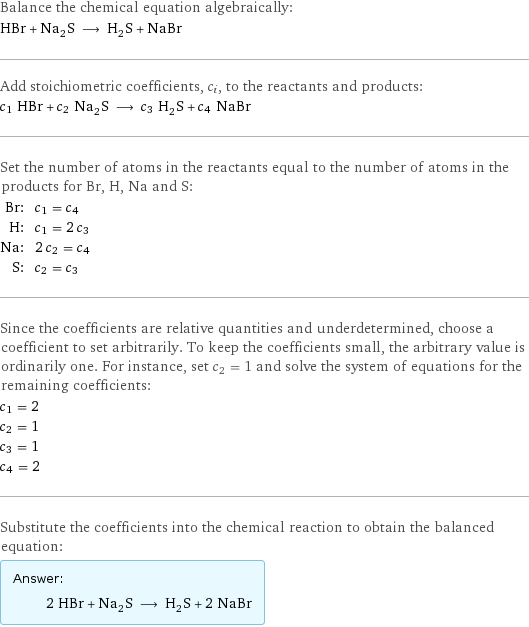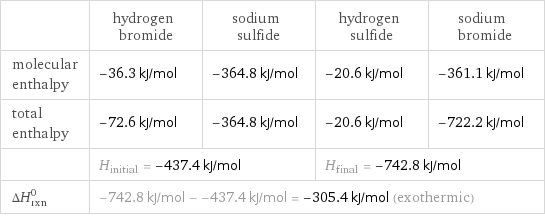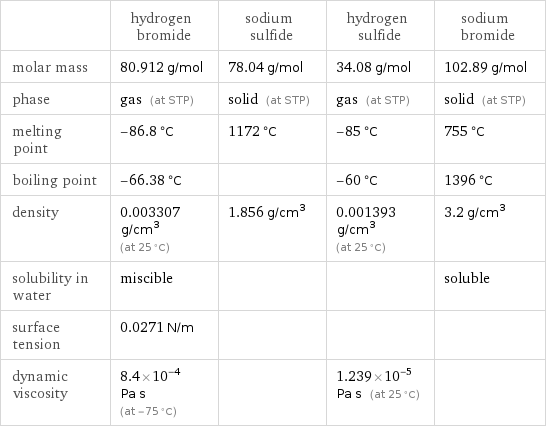Input interpretation

HBr hydrogen bromide + Na_2S sodium sulfide ⟶ H_2S hydrogen sulfide + NaBr sodium bromide
Balanced equation

Balance the chemical equation algebraically: HBr + Na_2S ⟶ H_2S + NaBr Add stoichiometric coefficients, c_i, to the reactants and products: c_1 HBr + c_2 Na_2S ⟶ c_3 H_2S + c_4 NaBr Set the number of atoms in the reactants equal to the number of atoms in the products for Br, H, Na and S: Br: | c_1 = c_4 H: | c_1 = 2 c_3 Na: | 2 c_2 = c_4 S: | c_2 = c_3 Since the coefficients are relative quantities and underdetermined, choose a coefficient to set arbitrarily. To keep the coefficients small, the arbitrary value is ordinarily one. For instance, set c_2 = 1 and solve the system of equations for the remaining coefficients: c_1 = 2 c_2 = 1 c_3 = 1 c_4 = 2 Substitute the coefficients into the chemical reaction to obtain the balanced equation: Answer: | | 2 HBr + Na_2S ⟶ H_2S + 2 NaBr
Structures

+ ⟶ +
Names

hydrogen bromide + sodium sulfide ⟶ hydrogen sulfide + sodium bromide
Reaction thermodynamics
Enthalpy

| hydrogen bromide | sodium sulfide | hydrogen sulfide | sodium bromide molecular enthalpy | -36.3 kJ/mol | -364.8 kJ/mol | -20.6 kJ/mol | -361.1 kJ/mol total enthalpy | -72.6 kJ/mol | -364.8 kJ/mol | -20.6 kJ/mol | -722.2 kJ/mol | H_initial = -437.4 kJ/mol | | H_final = -742.8 kJ/mol | ΔH_rxn^0 | -742.8 kJ/mol - -437.4 kJ/mol = -305.4 kJ/mol (exothermic) | | |
Gibbs free energy

| hydrogen bromide | sodium sulfide | hydrogen sulfide | sodium bromide molecular free energy | -53.4 kJ/mol | -349.8 kJ/mol | -33.4 kJ/mol | -349 kJ/mol total free energy | -106.8 kJ/mol | -349.8 kJ/mol | -33.4 kJ/mol | -698 kJ/mol | G_initial = -456.6 kJ/mol | | G_final = -731.4 kJ/mol | ΔG_rxn^0 | -731.4 kJ/mol - -456.6 kJ/mol = -274.8 kJ/mol (exergonic) | | |
Equilibrium constant
![Construct the equilibrium constant, K, expression for: HBr + Na_2S ⟶ H_2S + NaBr Plan: • Balance the chemical equation. • Determine the stoichiometric numbers. • Assemble the activity expression for each chemical species. • Use the activity expressions to build the equilibrium constant expression. Write the balanced chemical equation: 2 HBr + Na_2S ⟶ H_2S + 2 NaBr Assign stoichiometric numbers, ν_i, using the stoichiometric coefficients, c_i, from the balanced chemical equation in the following manner: ν_i = -c_i for reactants and ν_i = c_i for products: chemical species | c_i | ν_i HBr | 2 | -2 Na_2S | 1 | -1 H_2S | 1 | 1 NaBr | 2 | 2 Assemble the activity expressions accounting for the state of matter and ν_i: chemical species | c_i | ν_i | activity expression HBr | 2 | -2 | ([HBr])^(-2) Na_2S | 1 | -1 | ([Na2S])^(-1) H_2S | 1 | 1 | [H2S] NaBr | 2 | 2 | ([NaBr])^2 The equilibrium constant symbol in the concentration basis is: K_c Mulitply the activity expressions to arrive at the K_c expression: Answer: | | K_c = ([HBr])^(-2) ([Na2S])^(-1) [H2S] ([NaBr])^2 = ([H2S] ([NaBr])^2)/(([HBr])^2 [Na2S])](../image_source/3cbbef4d71522d8a2d21553693c62aa9.png)
Construct the equilibrium constant, K, expression for: HBr + Na_2S ⟶ H_2S + NaBr Plan: • Balance the chemical equation. • Determine the stoichiometric numbers. • Assemble the activity expression for each chemical species. • Use the activity expressions to build the equilibrium constant expression. Write the balanced chemical equation: 2 HBr + Na_2S ⟶ H_2S + 2 NaBr Assign stoichiometric numbers, ν_i, using the stoichiometric coefficients, c_i, from the balanced chemical equation in the following manner: ν_i = -c_i for reactants and ν_i = c_i for products: chemical species | c_i | ν_i HBr | 2 | -2 Na_2S | 1 | -1 H_2S | 1 | 1 NaBr | 2 | 2 Assemble the activity expressions accounting for the state of matter and ν_i: chemical species | c_i | ν_i | activity expression HBr | 2 | -2 | ([HBr])^(-2) Na_2S | 1 | -1 | ([Na2S])^(-1) H_2S | 1 | 1 | [H2S] NaBr | 2 | 2 | ([NaBr])^2 The equilibrium constant symbol in the concentration basis is: K_c Mulitply the activity expressions to arrive at the K_c expression: Answer: | | K_c = ([HBr])^(-2) ([Na2S])^(-1) [H2S] ([NaBr])^2 = ([H2S] ([NaBr])^2)/(([HBr])^2 [Na2S])
Rate of reaction
![Construct the rate of reaction expression for: HBr + Na_2S ⟶ H_2S + NaBr Plan: • Balance the chemical equation. • Determine the stoichiometric numbers. • Assemble the rate term for each chemical species. • Write the rate of reaction expression. Write the balanced chemical equation: 2 HBr + Na_2S ⟶ H_2S + 2 NaBr Assign stoichiometric numbers, ν_i, using the stoichiometric coefficients, c_i, from the balanced chemical equation in the following manner: ν_i = -c_i for reactants and ν_i = c_i for products: chemical species | c_i | ν_i HBr | 2 | -2 Na_2S | 1 | -1 H_2S | 1 | 1 NaBr | 2 | 2 The rate term for each chemical species, B_i, is 1/ν_i(Δ[B_i])/(Δt) where [B_i] is the amount concentration and t is time: chemical species | c_i | ν_i | rate term HBr | 2 | -2 | -1/2 (Δ[HBr])/(Δt) Na_2S | 1 | -1 | -(Δ[Na2S])/(Δt) H_2S | 1 | 1 | (Δ[H2S])/(Δt) NaBr | 2 | 2 | 1/2 (Δ[NaBr])/(Δt) (for infinitesimal rate of change, replace Δ with d) Set the rate terms equal to each other to arrive at the rate expression: Answer: | | rate = -1/2 (Δ[HBr])/(Δt) = -(Δ[Na2S])/(Δt) = (Δ[H2S])/(Δt) = 1/2 (Δ[NaBr])/(Δt) (assuming constant volume and no accumulation of intermediates or side products)](../image_source/eb4a98203c6f0c25c8736d43d4d4d4fd.png)
Construct the rate of reaction expression for: HBr + Na_2S ⟶ H_2S + NaBr Plan: • Balance the chemical equation. • Determine the stoichiometric numbers. • Assemble the rate term for each chemical species. • Write the rate of reaction expression. Write the balanced chemical equation: 2 HBr + Na_2S ⟶ H_2S + 2 NaBr Assign stoichiometric numbers, ν_i, using the stoichiometric coefficients, c_i, from the balanced chemical equation in the following manner: ν_i = -c_i for reactants and ν_i = c_i for products: chemical species | c_i | ν_i HBr | 2 | -2 Na_2S | 1 | -1 H_2S | 1 | 1 NaBr | 2 | 2 The rate term for each chemical species, B_i, is 1/ν_i(Δ[B_i])/(Δt) where [B_i] is the amount concentration and t is time: chemical species | c_i | ν_i | rate term HBr | 2 | -2 | -1/2 (Δ[HBr])/(Δt) Na_2S | 1 | -1 | -(Δ[Na2S])/(Δt) H_2S | 1 | 1 | (Δ[H2S])/(Δt) NaBr | 2 | 2 | 1/2 (Δ[NaBr])/(Δt) (for infinitesimal rate of change, replace Δ with d) Set the rate terms equal to each other to arrive at the rate expression: Answer: | | rate = -1/2 (Δ[HBr])/(Δt) = -(Δ[Na2S])/(Δt) = (Δ[H2S])/(Δt) = 1/2 (Δ[NaBr])/(Δt) (assuming constant volume and no accumulation of intermediates or side products)
Chemical names and formulas

| hydrogen bromide | sodium sulfide | hydrogen sulfide | sodium bromide formula | HBr | Na_2S | H_2S | NaBr Hill formula | BrH | Na_2S_1 | H_2S | BrNa name | hydrogen bromide | sodium sulfide | hydrogen sulfide | sodium bromide
Substance properties

| hydrogen bromide | sodium sulfide | hydrogen sulfide | sodium bromide molar mass | 80.912 g/mol | 78.04 g/mol | 34.08 g/mol | 102.89 g/mol phase | gas (at STP) | solid (at STP) | gas (at STP) | solid (at STP) melting point | -86.8 °C | 1172 °C | -85 °C | 755 °C boiling point | -66.38 °C | | -60 °C | 1396 °C density | 0.003307 g/cm^3 (at 25 °C) | 1.856 g/cm^3 | 0.001393 g/cm^3 (at 25 °C) | 3.2 g/cm^3 solubility in water | miscible | | | soluble surface tension | 0.0271 N/m | | | dynamic viscosity | 8.4×10^-4 Pa s (at -75 °C) | | 1.239×10^-5 Pa s (at 25 °C) |
Units
